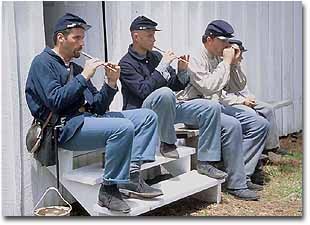History

Point Lookout is a peninsula formed by the confluence of the Chesapeake Bay and the Potomac River. It attracted attention from the outset of English colonization in America. Captain John Smith explored the Point in 1612. In 1632 it was included in King Charles I's grant to George Calvert, Lord Baltimore. Calvert's younger son, Leonard, Maryland's first governor, claimed the Point for his personal manor in 1634. During the American Revolution, and again in the War of 1812, it was the subject of British raids, and served as an American lookout point for a watchman to convey, via post riders, news of British fleet activity in the lower bay.
In 1830 the federal government erected a lighthouse on the tip of the Point. This lighthouse, though modified, is still in existence though it is no longer active. In 1857, William Cost Johnson, a wealthy Marylander, bought much of the land on the Point to develop as a resort. The Civil War intervened to disrupt Johnson's plan and in 1862, following General George B. McClellan's unsuccessful campaign to capture Richmond, the federal government erected Hammond Hospital at the tip of the Point. The ward buildings radiated in spoke fashion from a central bay. Wounded and sick soldiers began pouring in for treatment.
Prisoners of Point Lookout
The following year, after the Battle of Gettysburg, Union authorities started sending Confederate prisoners to Point Lookout for incarceration. As the prisoner population swelled to 20,000 and more, a wooden walled prisoner pen was constructed on the bay shore. The rebel captives were held inside and were given only tents for shelter. Exposure, disease, and starvation took their toll. Of the 50,000 men held at the Point between 1863 and 1865, nearly 4,000 died. Ironically, however, this death rate of 8 percent was less than half the death rate among soldiers who were in the field with their own armies.
In 1864, the Maryland Confederate General Bradley T. Johnson attempted a daring raid on the prison. His plan was to liberate the prisoners, arm them and march on Washington as part of General Jubal Early's offensive. Intelligence of his plan reached Union authorities in time for them to make preparations, and Johnson abandoned his plan when the Confederate authorities found out that the plans has been published.
"The bottom rail's on top now!" Among the Federal Army units to rotate from the front to serve as guards at Point Lookout were African-American soldiers of the U.S.C.T. Regiments (United States Colored Troops). Ironically, in some cases, these soldiers had occasion to guard their former masters, which led to instances of brutality, or of kindness, depending on the nature of their relationship previous to the war.
Sgt. Christian A. Fleetwood of the 4th U.S.C.T., a Baltimore native who had never been a slave, and Medal of Honor winner for his bravery at the Battle of Chapin's Farm in front of Richmond, and Sgt. Charles Douglass, of the 5th Massachusetts Colored Cavalry, and son of Frederick Douglass the noted black abolitionist, were among the soldiers rotating through Point Lookout. Elements of the Veteran Reserve Corps also served as guards, and in the hospital as orderlies and stewards. The First Regiment and Fourth Regiment U.S. Volunteers were organized from galvanized Confederate prisoners at Point Lookout, and shipped out from there for service in the west fighting Indians.
After the war a benevolent society attempted to salvage government property on the point to support the establishment of a home for disabled Union Army and Navy veterans. The effort was not successful due to the unusual speed with which the government officials dismantled the facilities and sold the scrap.